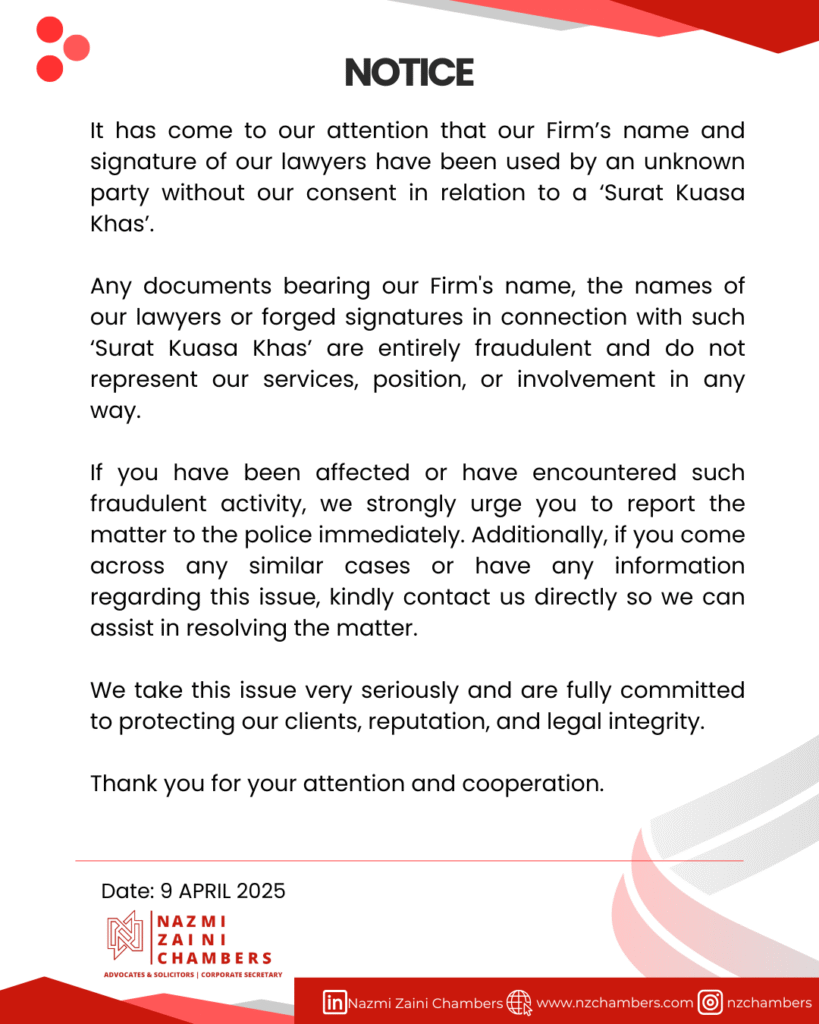INTRODUCTION
The amendments to Section 68(1)(f) of the Courts of Judicature Act 1964 (“CJA”) have raised important questions about the rights to appeal in civil proceedings. If the Section is read literally, Section 68(1)(f) CJA provides that no appeal shall be brought to the Court of Appeal where the High Court dismisses an application to strike out any writ or pleading. However, such interpretation cannot be sustained in every situation. It has been argued that many preliminary points of law are capable of finally determining the parties’ rights, and it cannot have been the legislature’s intention to compel parties to undergo the entire trial process in such cases. Accordingly, it was argued that Section 68(1)(f) CJA must be construed not in a purely literal or grammatical sense, but harmoniously with the wider provisions of the CJA so as to give effect to its true purpose.
The recent appeals in the Federal Court had addressed this issue in the cases of MTVentures Sdn Bhd & Anor v QM Print Sdn Bhd and Azinal Sdn Bhd v Jannath Gani & Ors and other appeals where the main area discussed was whether the parties have a right to appeal the dismissal of their striking-out applications, (as opposed to whether the striking-out applications themselves ought to succeed).
FACTS OF THE CASE
1. MT Ventures Sdn Bhd & Multi Top Auto Supplies Sdn Bhd v QM Print Sdn Bhd (“MT Ventures”)
QM Print Sdn. Bhd. (“the Respondent”) operated from premises at No. 24, Persiaran 118C, Desa Tun Razak Industrial Park, which were owned by Pan Mei-Yun, who authorised its use. Adjacent to these premises, at No. 22, were MT Ventures Sdn. Bhd. (“First Appellant”), the registered owner, and Multi Top Auto Supplies Sdn. Bhd. (“Second Appellant”), the tenant (collectively, “the Appellants”).
A fire allegedly originating from the Appellants’ premises caused damage to both properties. By a Letter of Assignment, Pan Mei-Yun assigned her rights to the Respondent, who then filed a claim on 23 August 2022 seeking damages. The Appellants applied on 12 December 2022 to strike out pursuant to Order 18 rule 19 pursuant to Respondent’s claim.
High Court Decision
The High Court heard and dismissed the Appellants’ Striking-Out Application on 10 May 2023. The Appellant, on 8 June 2023, filed a Notice of Appeal appealing this decision. The Respondent then filed to strike out the appeal, arguing that Section 68(1)(f) CJA was non-appealable in which it was granted and the Appellant’s appeal was struck out.
Court of Appeal Decision
The Court of Appeal majority agreed, holding that the amendment intended to Section 68 CJA to curb interlocutory appeals, and that the right to appeal vested in parties at the time the decision to dismiss the striking-out application was made and not when the suits were filed.
2. Azinal Sdn Bhd v Jannath Gani & Ors and other appeals (“Azinal”)
The main suit involves a dispute over the estates and assets of the late Datuk A.S. Dawood. The dispute centers on assets held by the family companies, where the main suit was filed in 2017. The matter is complicated by the existence of prior litigation concerning substantially similar subject matter. This decision can be found at Abdul Ravuff bin Datuk AS Dawood & Ors v Dr Abdul Rahiman bin Datuk AS Dawood (di dalam kapasiti beliau sendiri dan sebagai pentadbir harta pesaka Patama @ Ammaji Bibi bt Daud Sah) and other appeals.[1] This previous suit involved a challenge to the validity of the sale of the same 180 acres of land. Notably, the Plaintiffs in the current suit were not parties to that earlier litigation. The Appellant filed a striking-out application arguing that the Plaintiffs’ suit was barred by res judicata due to prior litigation involving the same matters.
High Court Decision
This application was dismissed by the High Court on 23 February 2023 where it was then appealed by the Appellant. The Respondents took a preliminary objection that this was a non-appealable ‘decision’ pursuant to Section 68(1)(f) CJA.
Court of Appeal Decision
The Court of Appeal upheld the Respondent’s preliminary objection, adopting a purposive approach to statutory interpretation. It held that the amendment to Section 68(1)(f) CJA was intended to curb interlocutory appeals that delay trials and burden the Court of Appeal, ensuring expeditious case disposal without affecting parties’ rights to a full trial. The court rejected the Appellants’ argument that the amendment applied only prospectively, ruling that it applied to decisions rendered after the amendment came into force, regardless of when the suit was filed. Distinguishing the authorities cited by the Appellants, the court noted those cases involved appeals after full trials, whereas the present case concerned an interlocutory matter. Accordingly, the Court allowed the preliminary objection and struck out the appeal as incompetent.
FEDERAL COURT
The Federal Court departed from the decisions of the High Court and Court of Appeal, holding that, while the dismissal of striking-out applications is generally not appealable, the parties in the present case possessed a vested substantive right to appeal the dismissal of their striking-out applications. In arriving at this conclusion, the Federal Court considered, among others, the following issues:
First issue: The position in law prior to the amendment to Section 68 CJA, in particular the construction of Section 3 CJA and Section 67 CJA
It is important to note the position of the pre-amendment where it highlights the need to read Section 68(1)(f) CJA holistically and in conjunction with Section 67 CJA and Section 3 CJA. The Federal Court first examined the effect of two leading cases Kempadang Bersatu Sdn Bhd v Perkayuan OKS No 2 Sdn Bhd[2] (“Kempadang”) and Asia Pacific Higher Learning Sdn Bhd v Majlis Perubatan Malaysia & Anor[3] (“Asia Pacific”).
In Kempadang, the Federal Court held that an order for reassessment of damages can be appealed. Zainun Ali FCJ clarifying that “judgment” and “order” in Section 67 CJA are encompassed within the definition of “decision” in Section 3 CJA, and that the amendment introducing the definition was clearly meant to cover civil appeals. It was further explained that Section 3 CJA contains two parts (1) the inclusive definition of “decision” and (2) the exclusion of interlocutory rulings that do not finally determine parties’ rights. Thus, Section 67 CJA must be read together with Section 3 CJA, meaning that the Court of Appeal’s appellate jurisdiction is delimited by the definition of “decision” under Section 3. By extension, Section 68 CJA, which imposes further limits on appeals, must also be read in conjunction with Sections 3 and 67 CJA.
Asia Pacific therefore both confirms and reiterates the legal position in Kempadang that when construing Section 67 CJA, it is necessary to consider Section 3 CJA. As stated by Idrus Harun FCJ, it is necessary to consider the second limb within the definition of ‘decision’ in Section 3 CJA which requires ascertaining whether there is a final disposition of the parties’ rights, in determining whether a matter is appealable or not.
Building on Kempadang and Asia Pacific, the Federal Court reasoned that Section 68(1)(f) CJA cannot be read in isolation but must be construed together with Sections 67 and 3 of the CJA. Section 67 CJA gives the Court of Appeal broad jurisdiction to hear civil appeals, but this jurisdiction is subject to limits in Section 68 CJA. Section 3 CJA, as clarified in Kempadang and Asia Pacific, defines a “decision” as one that finally disposes of parties’ rights, and excludes interlocutory rulings that do not. Reading these provisions together, Section 68(1)(f) CJA should be understood as clarifying that no appeal lies where an application to strike out is dismissed and no rights are finally determined. However, where the dismissal of a striking-out application results in the final disposal of parties’ rights, that order is a “decision” within Section 3 CJA and remains appealable under Section 67 CJA. Thus, Section 68(1)(f) CJA does not wholly bar appeals in every striking-out case, but only those where no substantive rights have been finally disposed of.
Purposive interpretation
The language of a statute cannot be fully understood before one has regard to its purpose. The purpose of the statute is to engage immediately, ambiguity or anything else is not a precondition to the consideration of purpose.[4] Even in other jurisdictions where there is no statutory frame of reference like our Interpretation Acts 1948 and 1967, it is made clear that the modern approach to statutory interpretation requires considering text based on its context and purpose.
Dismissal of Striking-Out Applications in General
When a court dismisses a striking-out application, it does not finally decide the parties’ rights but merely defers the issue to be determined at trial, once oral evidence is heard. Such a dismissal is therefore not a “decision” under Section 3 CJA, as it does not dispose of substantive rights but only removes the shortcut of avoiding a full hearing. The 2022 amendment to Section 68(1)(f) CJA did not create a new rule but clarified this long-standing position, since some litigants continued to file appeals despite no vested right of appeal existing. Read purposively, Sections 3, 67 and 68 of the CJA show that Parliament intended to prevent interlocutory appeals that cause delays, reserving appeals only for rulings that truly and finally determine the rights of parties.
Second issue: The position in law post amendment of Section 68 CJA
It was emphasized that Section 68(1)(f) CJA does not override Sections 3 and 67 of the CJA, in which it will constitute an appealable ‘decision’ under Section 3 CJA such that it falls within the Court of Appeal’s jurisdiction as conferred by Section 67 CJA. This means that even after the amendment, a dismissal of a striking-out application may still be appealable if it finally disposes of the parties’ rights. The Attorney-General, acting as amicus curiae, submitted that Section 68(1)(f) CJA should not be read as an absolute ban on appeals, and some dismissals of striking-out applications can still be appealed, particularly when the decision finally determines the parties’ rights.
The court agreed, noting that a literal reading of Section 68(1)(f) CJA could produce absurd results where a party could be irreparably prejudiced, forced to incur unnecessary time and expense, and denied access to a proper appeal, even when the High Court’s dismissal effectively resolves the dispute. Therefore, whether a striking-out dismissal is appealable depends on whether the decision finally determines the parties’ rights which produces a result that is fair, just and not bordering on absurdity, rather than on the procedural label of “striking-out.” This approach ensures that the Sections of the CJA are read harmoniously and that the purpose of the law, to allow appeals where substantive rights are finally decided, is preserved.
Third issue: Do the parties in the present case possess a right to appeal the dismissal of their striking-out applications?
On the facts before the Federal Court and in light of the legal test discussed earlier, the Appellants’ right in both cases of MT Ventures and Azinal to appeal is established in the present case. The Federal Court then scrutinized each case separately as below:
MT Ventures
The Appellants’ striking-out application primarily challenged the Respondent’s locus standi, arguing that the losses were incurred by Pan Mei-Yun (the owner of the premise) and that the Respondent therefore lacked the legal right to sue. The Appellants contended that it had been assigned the right to bring the claim under an absolute assignment pursuant to Section 4(3) of the Civil Law Act 1956, which the Appellants disputed. At its core, the issue concerns whether the Respondent satisfies the threshold requirement of locus standi to maintain the suit.
The Court highlighted the case of Bumiputra Commerce Bank Bhd v Augusto Pompeo Romei & Anor[5] where a court will not have jurisdiction to determine the issue where a party does not have locus standi.
The Court explained that while the Court of Appeal, in examining the striking-out application, might conclude that the locus standi objection is invalid or that a full trial is needed, the right to appeal the dismissal of the striking-out application is separate from the question of success. This is because the Appellants’ objection is jurisdictional in nature, they are entitled to appeal the dismissal, even though this does not guarantee that their appeal will succeed.
Azinal
The dispute in this case revolves around whether the Respondents’ claim is barred by res judicata, with the Appellants arguing that an earlier Federal Court decision covers the same issues and thus the suit should be struck out. The Respondents countered that they had adopted the findings of fact and law from the earlier case. Regardless, the Appellants’ objection is jurisdictional, challenging the court’s power to hear the matter. By dismissing the striking-out application, the court effectively resolves the Appellants’ right not to be subjected to duplicative litigation, even though the ultimate success of their res judicata claim may be determined later. Therefore, the Defendant’s right not to be subject to duplicative litigation would be finally disposed of in the dismissal of the present striking-out such that they are permitted to appeal.
Fourth issue: Alternative Approach to Resolution of These Appeals
Apart from the main conclusion, the Federal Court also examined the parties’ initial submissions and ruled on them as an alternative basis for the decision.
The court emphasized that the right to appeal is a substantive right. [6] The number of times parties can appeal has a direct and substantive effect on a party’s rights under the full suit.
The Court of Appeal in Azinal distinguished between a broad right to appeal the full merits of a suit and an interlocutory right of appeal, which arises from decisions made during the proceedings, such as striking-out applications. While the broad right to appeal is generally considered more significant, the Court recognized that interlocutory rights are still substantive when they affect the parties’ legal interests. Interlocutory applications can have a direct impact on parties’ substantive rights or other separate rights, and the ability to appeal such decisions is essential to prevent unfair prejudice or loss of legal protection. Because the right to appeal is substantive, any statutory provision that seeks to limit or remove this right, such as Section 68(1)(f) CJA, must be interpreted cautiously. Typically, statutes that take away substantive rights are applied prospectively, unless the law explicitly provides otherwise or it is clearly implied that retrospective application is intended.[7] This ensures that parties are not unfairly deprived of their legal rights under the guise of procedural amendments.
Generally, legislation is presumed not to have retrospective effect, as it would unfairly remove rights that have already been vested. This principle was illustrated in Lim Phin Khian v Kho Su Ming[8] (“Lim Phin Khian”). Although the general Macnaghten test provides that a right of appeal vests when the original proceedings are instituted, Gopal Sri Ram FCJ held that the strict application of this principle would have left the new Court of Appeal with no cases to hear for years, undermining its purpose. The Court therefore allowed a limited retrospective application of the statute, reasoning that strict adherence to the presumption against retrospectivity would have produced impractical and unjust outcomes, both for the parties and the functioning of the judicial system. This demonstrates that while retrospective application is generally disfavored, it may be justified where necessary to give effect to the legislative intent and practical operation of newly enacted laws. Gopal Sri Ram FCJ also highlighted that applying the Macnaghten presumption rigidly could cause manifest injustice, as parties could not have anticipated changes in the law that might affect their right of appeal. The solicitors, for example, could not foresee jurisdictional issues arising when filing the appeal.
In the present case, even if the Macnaghten presumption does not apply, the consequence is much less severe as the Court of Appeal might take longer to clear the backlog because it will have to hear more striking-out appeals, but this delay is minor compared to leaving the Court of Appeal empty for years. Therefore, Section 68 CJA should not be interpreted to override the Macnaghten presumption or operate retrospectively to remove vested rights of appeal that both parties possessed in the present case. Even if read literally, the section cannot strip parties of their already vested right to appeal a dismissal of a striking-out application, ensuring that the Appellants retain the right to challenge such decisions.
CONCLUSION
In conclusion, while dismissals of striking-out applications are generally non-appealable, the Appellants in this case do have a right to appeal due to the specific facts of their cases. Their substantive right to appeal was vested when they filed their suits and was not removed by Section 68(1)(f) CJA, which does not alter the law regarding this right. Section 68(1)(f) CJA only prevents appeals where the parties’ rights have not been finally determined, such as when further oral evidence is needed. In this case, the dismissal of the striking-out applications resolved the Appellants’ rights on preliminary legal points, meaning there was a final disposal under Sections 3 and 67 CJA. Therefore, the appeals were valid, and the Court ordered that both be reinstated and heard in full, making it unnecessary to address the leave questions.
COMMENTARY
In this case, The Federal Court has now settled the principle that not all dismissals of striking-out applications are automatically unappealable under Section 68(1)(f) CJA. The appealability of a dismissal of a striking-out application under Section 68(1)(f) CJA depends whether it disposes of the rights of the parties finally or not. If the court refuses to strike out a case because it thinks there are issues that should be decided at trial, that decision does not finally determine the parties’ rights, it just means the matter will continue to trial, so it cannot be appealed.
However, where the dismissal conclusively disposes of substantive matters as in MT Ventures, where locus standi was finally determined, or Azinal, where res judicata prevented the case from continuing, then the order will amount to a “decision” within Section 3 CJA and remains appealable under Section 67 CJA. Going forward, counsel must consider whether the dismissal of a striking-out application finally settles the parties’ rights or merely delays the issue to be decided at trial, as this distinction will determine whether the order is appealable.
These decisions make clear that not every striking-out dismissal can be appealed. The rule prevents unnecessary appeals that only delay trials, but at the same time it allows appeals where the dismissal decides key issues like above cases such as locus standi or res judicata, which could seriously affect rights of the parties finally or not. Still, whether a dismissal is procedural or final will depend on the facts of each case, and future courts will need to decide this carefully.
[1] [2022] MLJU 830
[2] [2019] 4 MLJ 614
[3] [2020] 2 MLJ 1
[4] Detik Ria Sdn Bhd v Prudential Corporation Holdings Ltd & Anor [2025] MLJU 575
[5] [2014] 3 MLJ 672
[6] Sia Cheng Soon & Anor v Tengku Ismail bin Tengku Ibrahim [2008] 3 MLJ 753.
[7] Tenaga Nasional Bhd v Kamarstone Sdn Bhd [2014] 2 MLJ 749
[8] [1996] 1 MLJ 1






